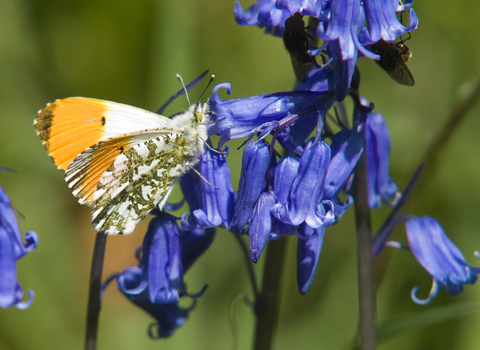
Orange-tip ©Bob Coyle

©Ross Hoddinott/2020VISION
Orange-tip
It’s easy to see where these butterflies get their name – the males have bright orange tips on their wings! See them from early spring through to summer in meadows, woodland and hedges.
Scientific name
Anthocharis cardaminesWhen to see
April to JulySpecies information
Category
Statistics
Wingspan: 4.0-5.2cmCommon.
About
These pretty little butterflies are easy to spot as the males’ wings have bright orange tips – giving them their name! They are a common sight during spring and can be found in lots of places including meadows, woodland and hedges. The adults lay their eggs on special plants to ensure that their caterpillars have the right food to eat. Orange-tip caterpillars love garlic mustard, cuckooflower and hedge mustard plants.How to identify
The male orange-tip is unmistakeable: a white butterfly, half of its forewing is a bold orange, and it has light grey wingtips. The female is also white, but has grey-black wingtips, similar to the white butterflies. Both sexes show a mottled, 'mossy grey' pattern on the underside of their hindwings when at rest.Distribution
Found across the UK, although scarcer in the north of Scotland.In our area
How to attract orange-tip and other butterflies into your garden
Provide food for caterpillars and choose nectar-rich plants for butterflies and you’ll have a colourful, fluttering display in your garden for many months. Read more
Did you know?
Orange-tip caterpillars are cannibals, eating their own eggshell when they emerge and moving on to eat other orange-tip eggs nearby. Caterpillars pupate in July and overwinter as a pupa, emerging as butterflies the following spring.How to attract orange-tip and other butterflies into your garden
Provide food for caterpillars and choose nectar-rich plants for butterflies and you’ll have a colourful, fluttering display in your garden for many months. Read more
